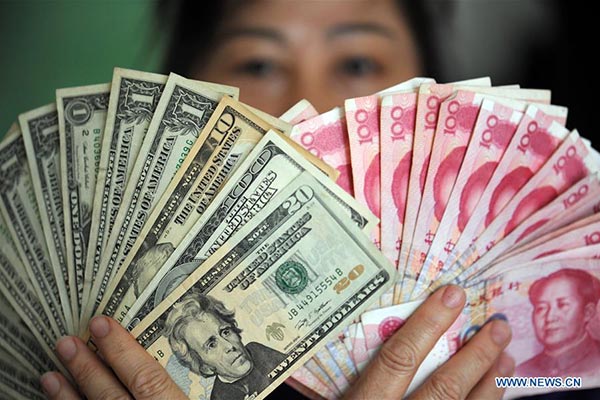
A residents shows China's yuan and US dollar banknotes in Qionghai, South China's Hainan province, Jan 7, 2016. (Photo/Xinhua)
The first quarter macroeconomic data the National Bureau of Statistics has released suggest a promising year ahead for China. Given the complicated economic situations at home and abroad, it is encouraging to see the Chinese economy avoiding a severe downturn-as feared by some observers-reducing the risk factors, starting to stabilize, and showing initial industrial advantages in the fiercely competitive international market.
Despite being the lowest since 2009, China's 6.7 percent GDP growth in the first quarter of 2016 is still very healthy, especially if seen in the light of the "China collapse" rumors that were doing the rounds a few months ago. The 6.7 percent growth is not only within the 6.5 to 7 percent growth expectation of the central government, but also among the fastest in major economies.
Judging from the macroeconomic data, the risk factors posing the greatest threat to China's economy have been reduced. The remarkable achievement in real estate destocking will give those who worried the housing market would collapse and repeat the scenario in Japan enough reasons to breathe a sigh of relief.
In the previous two years, China's housing market did suffer a lingering slump, with commercial housing sales nationwide declining by 7.6 percent in 2014 and that in the first two months of 2015 falling by a whopping 16.9 percent. Home sales stabilized only in June last year.
Because of the slump in sales, the total housing floor area under construction saw a moderate increase on a monthly basis while the completed floor area declined considerably. For example, despite a 1.3 percent increase in the floor area under construction in 2014, the completed floor area declined by 6.9 percent year-on-year, which means an increase in the number of unfinished housing projects. Such a scenario in other countries would almost inevitably result in the collapse of the real estate sector.
China, however, presents a different picture. After robust, targeted and effective macroeconomic measures, housing sales in the first quarter of this year reached 242.99 million square meters in terms of floor area, an increase of 33.1 percent year-on-year. Of this, the sale of residential housing saw a 35.6 percent rise. And increased housing sales prompted real estate investment in the first quarter to grow by 6.2 percent year-on-year, 5.3 percentage points higher than the full-year investment growth in 2015.
Due to its strong links to the banking sector and a series of upstream and downstream industries, the recovery of the housing market will be of huge importance to not only China's real economy, but also its financial system. This is also a reflection of China's relatively strong economic capability to resist risks.
The better-than-expected economic situation is reflected in the rise in industrial enterprises' profits too. Compared with a 2.3 percent decline in their total profits in 2015, their profits reached 780.7 billion yuan ($120.87 billion) in the first two months of this year, an increase of 4.8 percent year-on-year.
This, along with the accelerated growth of industrial added value in the first quarter and a relatively high sales-production ratio for industrial enterprises above a certain size, means a solid foundation is being laid down for China's real economy. Also, the faster growth of the high-tech and equipment manufacturing sector has raised hopes for the country's industrial structural upgrading.
The first quarter data also raises hopes of China overcoming the impact of its aging population, further realizing the potentials of its human resources and maintaining its economic and social vitality. For example, in absolute terms, the country's working-age population has been declining in recent years, but the flow of labor force from rural areas has seen a rise, meaning a continuous improvement in the efficient use of labor.
In the final analysis, despite the global economic and industrial slump, China should manage to keep its economic growth rate higher than its competitors, although the future growth rate may be moderately lower than in previous years. And all this will help it further raise its status and expand its influence in the global economy.
The author Mei Xinyu is a researcher at the Ministry of Commerce's International Trade and Economic Cooperation Institute.


















































